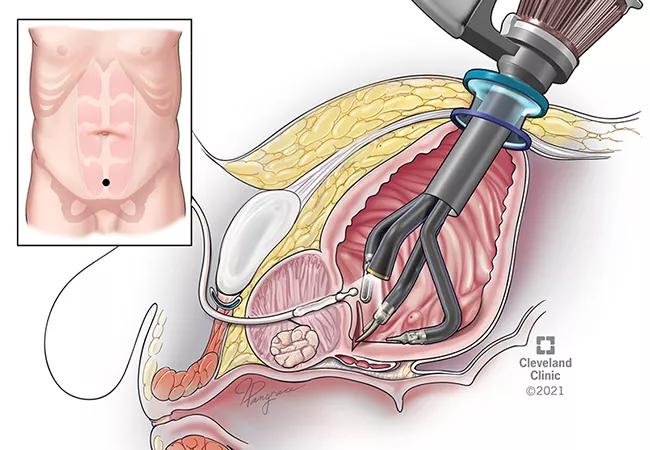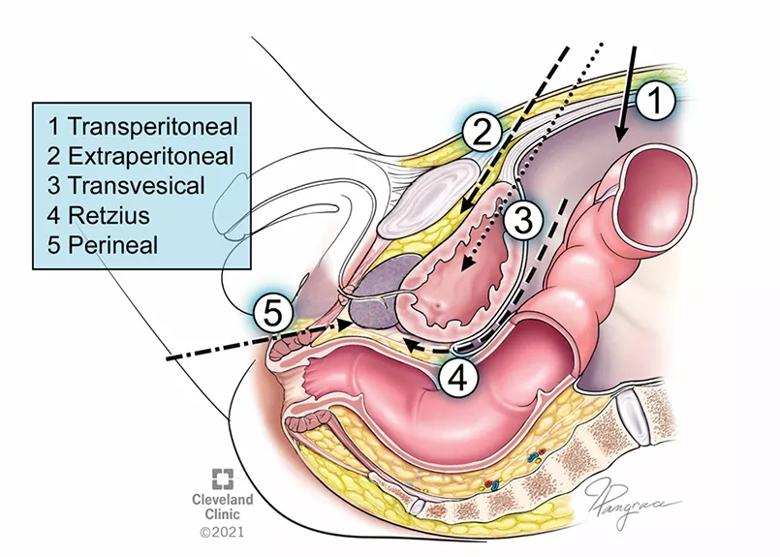Single-port robot-assisted transvesical prostatectomy is enabling new approaches

Efforts to regionalize robotic prostatectomies have opened the door for another innovation in urologic surgery. Patients can now undergo prostate surgery with epidural anesthesia and light sedation, known as twilight sleep, without the need for a ventilator general anesthesia.
Advertisement
Cleveland Clinic is a non-profit academic medical center. Advertising on our site helps support our mission. We do not endorse non-Cleveland Clinic products or services. Policy
Jihad Kaouk, MD, recently completed a series of 15 single-port transvesical radical prostatectomies with an epidural anesthesia regimen. He explains how a newer technique—single-port (SP) robot-assisted transvesical prostatectomy—has made this anesthesia regimen possible:
“Robotic surgery requires pumping gas into the patient’s belly to create a surgical field in a gas bubble for visualization and maneuvering. Under pressure, it expands and alters the movement of the diaphragm, preventing the patient from breathing spontaneously,” he says. “This has traditionally necessitated the use of a ventilator machine under general anesthesia — with or without spinal or epidural anesthesia.”
“But as we continue to regionalize the surgery limited to the location of the disease, as in the case of the SP transvesical prostatectomy, that gas bubble is no longer in the intraperitoneal space: it’s limited inside the bladder, so it’s not pushing on the diaphragm,” he explains.
Dr. Kaouk, Director of the Center for Robotic and Image-Guided Surgery in Cleveland Clinic’s Glickman Urological & Kidney Institute, worked closely with Mauricio Perilla, MD, of the Department of General Anesthesiology, to prepare, coordinate and implement this approach.
The patients selected for the epidural underwent prostatectomy for either prostate malignancies or enlarged prostate but were otherwise healthy with no other underlying disease or comorbidities. “We wanted to minimize the variables,” says Dr. Kaouk. “This is important when you establish a new approach. Our goal was to show the feasibility, safety, and efficacy of doing an epidural for this type of surgery.”
Advertisement
The teams involved established a plan B in advance of the first case in the unlikely event that the patient moved, vocalized pain or unknowingly reached into a sterile field. “It takes a minimal amount of time to intubate and continue with the surgery, and the team was on standby in case that was required,” he says, but was not needed in any case.
The transvesical approach enables surgical access to the prostate through the bladder, avoiding the intraperitoneal cavity entirely. As a result, Dr. Kaouk explains, patients experience less pain and postoperative ileus because the bowels stay intact. In 2021, Dr. Kaouk and colleagues were the first to report their experience and early outcomes of this technique for radical prostatectomy and pelvic node dissection. It has become a preferred option in select patients with low- to intermediate-risk prostate cancer, Dr. Kaouk says.
Early results demonstrated a significant impact on urine control (50% had immediate continence), short postoperative Foley duration (three days post-surgery), minimal perioperative complications, limited use of opioids for pain control, low risk for transfusion, and fast recovery, with about 87% of patients in an outpatient setting within four hours of surgery.

Figure. Illustration shows several options to perform robotic radical prostatectomy at Cleveland Clinic, leading to what Dr. Kaouk calls “a custom-make approach to improve outcomes.”
For most patients, general anesthesia is a safe and appropriate option. But in patients with underlying neurologic or respiratory disorders who may be advised to avoid general anesthesia, epidural anesthesia may be a safe alternative.
Advertisement
Contraindications aside, some patients simply prefer to maintain consciousness if given the option, asserts Dr. Kaouk. “Going forward, an epidural for SP simple or radical transvesical prostatectomy will become an option as part of the medical decision-making process. And we will recommend it to patients when there are possible benefits.”
He continues, “I’ve had patients tell me that they want the surgery but are terrified of being intubated completely under general anesthesia, or there are medical reasons precluding them from use of general anesthesia. So it feels great to be able to give them this option.”
Advertisement
Advertisement

Pediatric urologists lead quality improvement initiative, author systemwide guideline

Fixed-dose single-pill combinations and future therapies

Reproductive urologists publish a contemporary review to guide practice

Two recent cases show favorable pain and cosmesis outcomes

Meta-analysis assesses outcomes in adolescent age vs. mid-adulthood

Proteinuria reduction remains the most important treatment target.

IgA nephropathy is a relatively common autoimmune glomerular disease that can be diagnosed only by biopsy

Oncologic and functional outcomes are promising, but selection is key